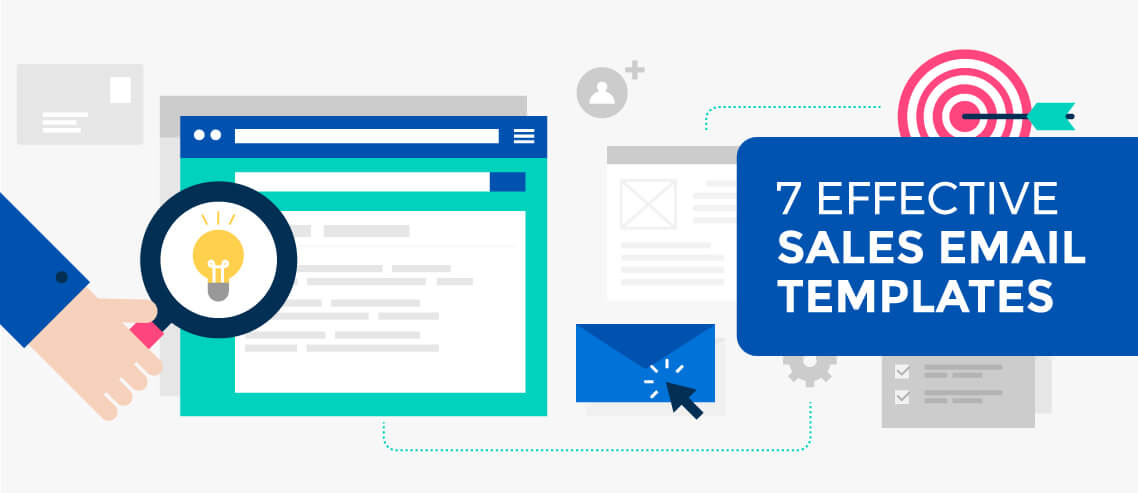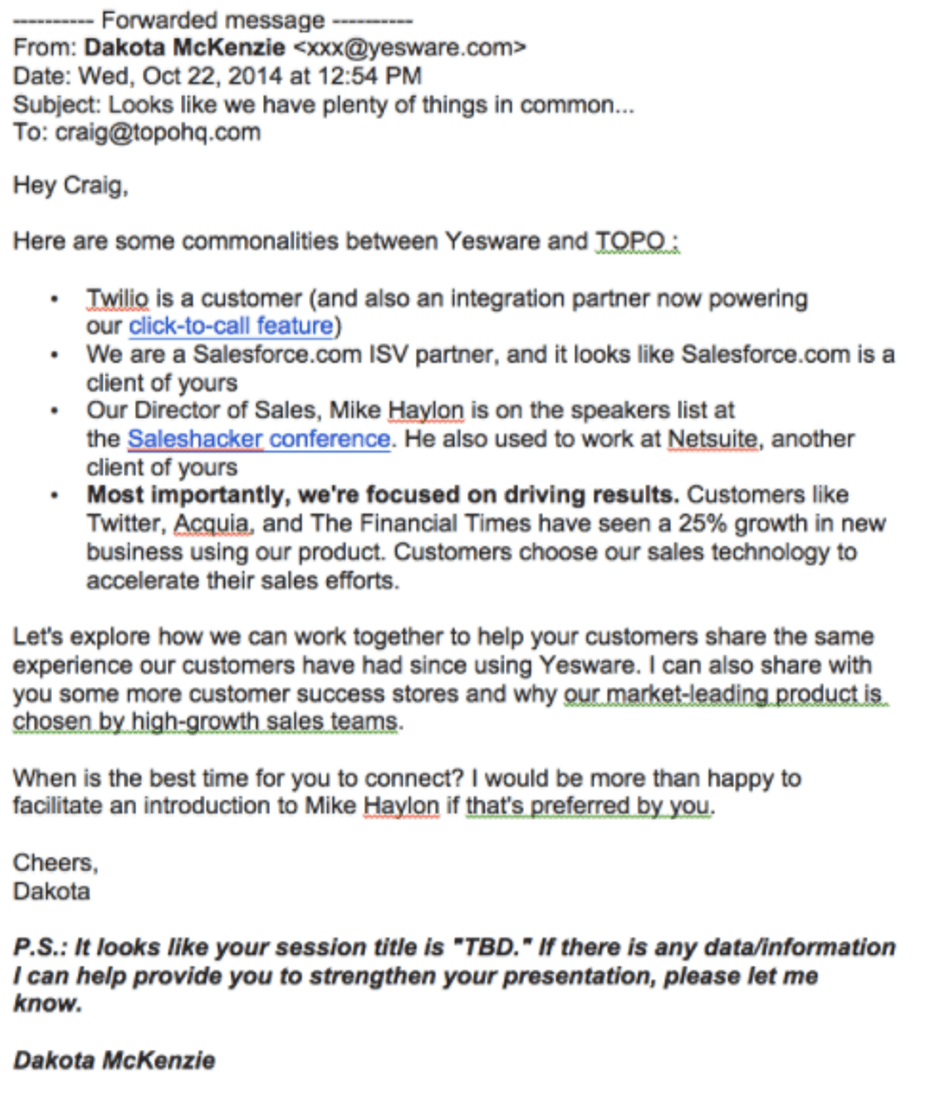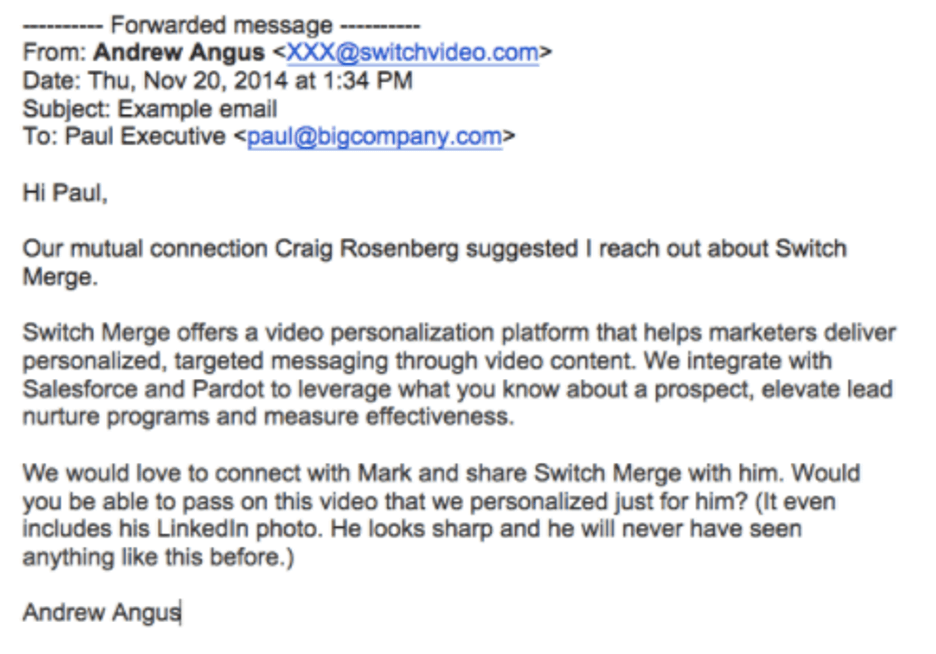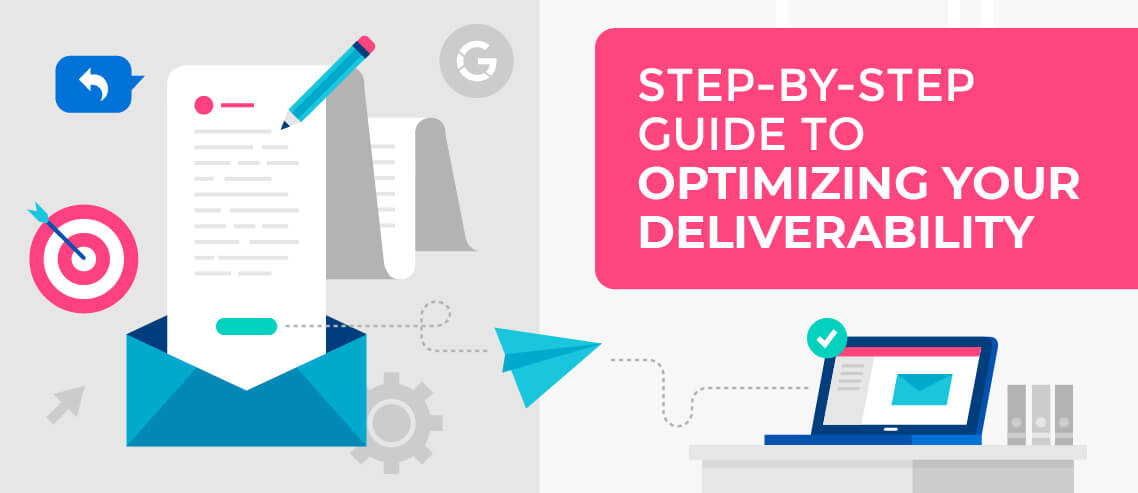17 Sales Email Templates + Examples & Best Practices

Contents
Writing effective sales prospecting email templates takes serious practice. You’ve got to be interesting enough to get recipients’ attention, convincing enough to hold that attention long enough to get them to read your entire pitch, and thoughtful enough to come across like you have their best interests in mind. And you’ve got to do all that in a handful of sentences.
Sounds tough, right? The truth is, it doesn’t have to be.
Most salespeople go wrong by writing emails that are too long, too self-centered, and that provide little or no value to the recipient. Naturally, the majority of those emails get dismissed or marked as spam the moment they arrive in the inbox. In fact, only 24% of prospects open sales emails.
Seasoned salespeople, on the other hand, know that getting someone to open and read their email is half the battle. The other half boils down to making the email brief and to the point, jam-packing it with value, and ending it in a way that provokes action.
- How to Write Sales Emails That Get Responses
- 17 Sales Prospecting Email Templates
- How to personalize your outreach at scale
- Sales Prospecting Email Examples
- How to Use Templates Effectively
How to Write Sales Emails That Get Responses
Here’s a simple four-line structure you can follow for your sales emails, and seven sales email templates you can steal and make your own.
1. Opening Line
Address recipients by their name, state the reason for the email, and above all else, make it more about them than about you.
2. Offer Line
Highlight a pain point and do your best to personalize it to their situation simultaneously. The offer line can also be a great place to provide evidence and social proof in the form of statistics, case studies, and exclusive content.
3. Closing Line
End with a short and clear call-to-action that can be answered with a simple “yes” or “no.” That no-friction ask makes it more likely you’ll get a response.
4. Signature Line
Reframe your mindset by thinking of your email signature as a personal high converting landing page. It should contain the basics, like name, company, and contact info, of course, but think about what else you can add, such as social proof, rewards, links to relevant content, and anything else that shows credibility and builds rapport.
Sales Prospecting Email Templates
1. The “Permission Wanted”
[ms_email_template id=4653 /]
Why It Works: Getting permission is intriguing because nobody else does it. Doing so shows respect, build trusts, and, if done correctly, can leave someone in suspense. For instance, the email above doesn’t jump right into the product or service the salesperson is trying to pitch. Nor does it ask for a demo or a meeting. Instead, it piques interest, suggests future value, speaks to the prospect’s goals, and ends with an easy ask they can respond to with a simple “yes” or “no.”
2. The “Help Me, I’m Lost”
[ms_email_template id=4654 /]
Why It Works: People inherently want to be helpful, so asking for some direction can be an easy win. When this template works as it should, you’ll also have somewhat of an internal referral when you do send that second email. You can start the next email with “Jesse in Marketing mentioned I should reach out to you to discuss [pain point].” Doing so will add credibility and increase the chances of getting a response.
3. The “Rapport Builder”
[ms_email_template id=4655 /]
Why It Works: Pre-call discovery can work wonders for building rapport. Use websites like LinkedIn Sales Navigator to find common connections, shared experiences, or similar interests. Most people are also active on some form of social media, which can be an excellent place to find out what they’re into and what you can use to break the ice and start a conversation, like this sales email template does.
4. The “Problem Solver”
[ms_email_template id=4656 /]
Inspired by Dan Murphy at Culture Amp writing for Sales Hacker
Why It Works:
Showcasing a relevant problem, sharing a relevant success story, and making a simple offer cuts right to the chase, which can be a refreshing change of pace from all the awkward attempts to establish mutual connections and interests.
5. The “Friend Of A Friend”
[ms_email_template id=4657 /]
Inspired by Forster Perelsztejn at Prospect.io
Why It Works: A sales email template that highlights a mutual connection can help lower the recipient’s guard more quickly than normal, and possibly win you credibility right off the bat. It’s worth noting that the first sentence about sharing a meal really packs a punch because it shows you aren’t just a random acquaintance leveraging their name. Instead, you’ve provided proof of said relationship, and the email itself comes off more like a partnership than a sales pitch.
6. The “Classic AIDA”
[ms_email_template id=4658 /]
Why It Works: AIDA works because it follows an effective structure borrowed from the popular sales technique:
Attention: Seize their attention
Interest: Explain clearly why the product or service is of value to the prospect
Desire: Build up a desire for your product or service
Action: End strong by outlining how they can take full advantage of the offer
Each line builds upon the last and compounds interest until prompting action. AIDA is a classic technique that works, and should be part of every salesperson’s arsenal.
7. The “Giver”
[ms_email_template id=4659 /]
Inspired by Gabriel Swain of Agile CRM
Why It Works: Sending relevant content from your blog, industry research firms, or even just book recommendations can go a long way towards building rapport and capitalizing on the principle of reciprocity. This sales email template works best if you pair it with high-quality relevant content that is either interesting, teaches them something useful, or both. Sharing content also makes the follow-up easy since you can ask for their thoughts on the content previously shared.
The anatomy of your sales email templates boils down to making them easy to read, providing value, and ending on an action-provoking question or request that’s easy to say yes to.
Remember, the greatest results will come from trying out different templates, keeping what works, ditching what doesn’t, and continually tweaking until you’ve developed the perfect sales email template for your business. Sending sales emails is a game of persistence. You won’t find success overnight, but with the right template, you can deliver substantial benefits to your business in no time.
8. Before-After-Bridge
This is all about detailing a problem that exists in your prospect’s industry, then describing how fantastic things would be if that problem didn’t exist. Finally, you offer a solution – presumably something related to your product.
Here’s how it looks in practice:
[ms_email_template id=5293 /]
9. Features-Advantages-Benefits
Simple but effective, this copywriting formula involves detailing two or three key features of your product, explaining why they’re helpful, and then detailing exactly what this means for your prospect.
Here’s how it works:
[ms_email_template id=5353 /]
10. The 5 Basic Objections
Almost every time a prospect doesn’t buy from you, it’s because of one (or more) of these five reasons:
- I don’t have enough time
- I don’t have enough money
- It won’t work for me
- I don’t believe you
- I don’t need it
I’m not suggesting you should aim to overcome all of those objections every time you send an email – you’ll likely come across as overly defensive if you try to do so. But you should definitely keep them in mind when writing your email copy. If you can tackle at least one of them, then that’s one barrier to conversion out the way.
Here’s how to do it:
[ms_email_template id=5354 /]
11. The Cliffhanger Ending
No one can resist a cliffhanger finale – it’s basically hard-coded into us to demand closure. When we don’t get it, we need to know more.
Here’s how to take advantage of this principle in your cold emails:
[ms_email_template id=5355 /]
12. Write for One Person, Not Thousands
Legendary advertiserFairfax Cone did a better job than most of defining superb copywriting when he explained: “Good advertising is written from one person to another.”
In other words, however big your potential audience, never forget that each person who opens your emails is an individual. They have their own priorities and pain points. It’s up to you to tap into them.
Here’s what I mean:
[ms_email_template id=5356 /]
13. ACCA
Every time you write a cold email, you should have a clear target action in mind. Never make the reader second-guess how you want them to proceed. The ACCA formula is a great tool for this, because it’s super actionable. ACCA stands for:
- Awareness: Outline the situation or problem
- Comprehension: Explain how it affects your prospect, and how you have the solution
- Conviction: Create a desire for the solution you’re offering
- Action: Call to action
Here’s how to put this formula to work:
[ms_email_template id=5357 /]
14. “So What?”
Kids would make brilliant cold emailers. Why? Because they’re always asking “so what?”
Every time you write a sentence, ask yourself the same question. In other words, why would the recipient care about the thing you’ve written? It’ll keep your copy punchy and actionable.
Here’s the difference this practice can make:
[ms_email_template id=5358 /]
15. The String Of Pearls
Right now, brands are obsessed with “storytelling”. But this isn’t some airy marketing buzzword; crafting compelling stories gets real results.
That’s what the “String Of Pearls” formula is all about – weaving together two or three persuasive examples of your product in action to create one attention-grabbing email.
Here’s an example:
[ms_email_template id=5359 /]
16. Be Specific (But Give Nothing Away)
Similar to the Cliffhanger Ending technique, this copywriting formula is all about teasing the reader into learning more. Give them a tantalizing line of copy that goes into specifics while still allowing you to keep your cards close to your chest. It’s not easy to do – but it works.
Here’s a sample for your review:
[ms_email_template id=5360 /]
17. The OATH Formula
Another kick-ass method to keep your cold emails laser-focused is to consider the four stages of audience awareness:
- Oblivious: Completely unaware of you
- Apathetic: Aware of you, but disinterested
- Thinking: Potentially interested in what you have to say
- Hurting: In desperate need of a solution that you can offer
Figure out which of these four stages your prospect falls into and use this insight to hone your copy.
Here’s an example targeting the “oblivious” stage:
[ms_email_template id=5361 /]
How to personalize your outreach at scale
Most sales emails don’t need to be hyper-personalized. An easy formula to follow when deciding how to personalize your emails are:
- Different emails for different targets
- Research individuals and personalize the first sentence
For instance, at Mailshake, two groups that we target are salespeople within sales teams, and consultants doing their own prospecting.
Obviously, these two groups have different characteristics and pain points, so my emails to both will be different.
On an individual level, though, I can take 5 minutes per prospect, check their LinkedIn, website, and other social accounts, and find an angle to open my email that connects to my offer and shows that this isn’t the exact same email I’m sending to hundreds of other people.
With Mailshake, you can personalize your emails in bulk with powerful mail merge features, schedule follow-up emails that are paused or triggered based on whether a a recipient opens an email, clicks a link, or replies, and reply to leads straight from your Mailshake dashboard with Lead Catcher.
You can also set the amount of time between follow-ups (5 days between the first and second email, 7 days between the second and third, etc.), and the days and times you want them to send (for instance, between 8 am and 6 pm on weekdays).
[lyte id=”ug3EwoMeCPk” /]
Optimize your copy and overall outreach strategy by AB testing different subject lines, body copy, and full campaign sequences. And with native integrations to your CRM, and third party integrations to hundreds of software tools via Zapier, you can automate your outreach even further by triggering campaigns when someone downloads an eBook, books a meeting, or signs up for a demo.
If social media and phone are a part of your outreach cadence, you can include those touch points in your outreach cadences as well with Mailshake Sales Engagement.
Bottom line: personalizing is absolutely essential to an effective outreach strategy, but it’s only one piece of the puzzle, and there’s no reason why you can’t automate it.
Sales Prospecting Email Examples
1. The “Rapport Builder”
 [Source]
[Source]
Why it works: The sales rep has used the “rapport builder” structure. This demonstrates that not only are there several mutual connections and commonalities between the two organizations, but that she has done plenty of research ahead of the email. She then closes by positing a solutions-focused business relationship, rather than a product relationship, making a very strong case for a response.
2. The “Problem Solver” and “Rapport Builder”

[Source]
Why it works: The sales rep leads with a strong rapport building hook: that both parties have lived in Oregon, and that the prospect has potentially worked with the company before. This demonstrates that he has researched the company and makes it difficult for the prospect not to reply. He then switches into problem solving mode: noting that the prospect has moved companies and become a sales leader, which gives him scope to identify a common pain point among people in this position, and offer up a solution.
3. The “Giver”

[Source]
Why it works: The sales rep begins by complimenting Hubspot’s brand, and solidifies this by linking to a recent article he liked. This is a useful way to personalize cold emails. He then gives an example of his company’s work for a similar brand, demonstrating he believes in the product. Finally, he links to a demo he has made “for you,” showing that he’s gone the extra mile and has put work into this relationship before it has even begun. This was a genuinely custom video, showing the type of work he would produce should the relationship go further.
4. The “Friend of a Friend”
 Why it works: This is a simple example of the “Friend of a Friend” approach. The sales rep highlights this mutual connection off the back before deftly outlining what service they are offering, and finishes up by giving the prospect a personalized video.
Why it works: This is a simple example of the “Friend of a Friend” approach. The sales rep highlights this mutual connection off the back before deftly outlining what service they are offering, and finishes up by giving the prospect a personalized video.
How to Use Templates Effectively
Templates are great. They can inspire you to create email copy that engages your prospects and persuades them to take action – and they can help you speed up your results at the same time.
But they’re no silver bullet.
Copypasta never works. No sales rep should expect to simply paste a template into a blank email, swap in their prospect’s name, hit “send,” and expect to see results. Buyers are savvy; they can tell when they’re being hit with a template rather than a genuine, personalized email – and they’re unlikely to be impressed.
So how should you use templates? Which emails are they best suited for use in? And what degree of editing do they require for best results?
Rex Bibertson shared a few tips with me in a recent video call. I’ve summarized some of the key takeaways below, but watch the video below and check out the full article if you want to learn more.
[lyte id=”WLdPdvihXyM” /]
Templates are best used for repeatable messages.
Rex most commonly uses templates for highly repeatable messages – things like meeting follow-ups. Same goal, same information. But what about more complex scenarios, like cold outreach? Should you ditch the templates altogether? Absolutely not; but using them requires a little more effort on your part.
What works for one business won’t necessarily work for you.
Don’t take those articles saying, “This Email Template Drove $1M in Net New Sales in Three Months” at face value. No doubt the email copy played a part, but so did the industry, the product, the price point, the location, and dozens of other factors.
Use templates as creative inspiration.
Chances are you receive plenty of cold emails yourself. Or you might have seen some great examples posted on LinkedIn. Again, don’t just rip them off. But you should absolutely use them as creative inspiration. Much like the countless meme formats on Twitter, there’s nothing wrong with taking a winning format and iterating on it.
Ask yourself: Does it make sense to leverage an offer template?
Some of the most effective emails involve special offers – things like free trials and big discounts. The offer is the reason that these messages are successful. So there’s little point in sending a similar email but with a much less compelling offer. It just won’t work.
When personalizing, do your research in batches.
Rex spends two hours at a time on LinkedIn picking out key facts about his prospects. Using those facts, he’ll craft a single sentence for each prospect that can be slotted straight into a template email. In that time, he can usually do enough research to personalize emails to 100 different prospects.
Personalize by category, rather than one-to-one.
Another great tip for adding personalization at scale: add personalized elements based on a type of prospect, rather than an individual. For instance, CEOs of SaaS startups generating up to $500,000 in revenue will likely have similar experiences and pain points. Figure out what your product can do for that category of customer, and reference it in your emails.
Been given advice on email length? Ignore it!
Rex doesn’t believe there’s any “perfect” email length. Sure, you’ll almost always want to keep it as brief as possible, but that doesn’t necessarily mean it has to be fewer than 100 words (or any other arbitrary amount). Short on its own isn’t good enough; there needs to be a compelling hook – a reason for your prospect to respond – as well.
The anatomy of your sales email templates boils down to making them easy to read, providing value, and ending on an action-provoking question or request that’s easy to say yes to.
Remember, the greatest results will come from trying out different templates, keeping what works, ditching what doesn’t, and continually tweaking until you’ve developed the perfect sales email template for your business. Sending sales emails is a game of persistence. You won’t find success overnight, but with the right template, you can deliver substantial benefits to your business in no time.




